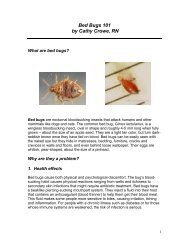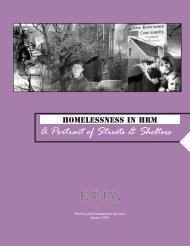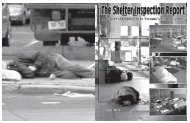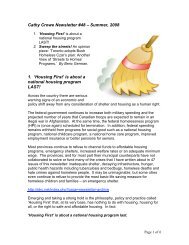Cathy Crowe Newsletter #56 - May, 2009 Nurses Week Edition 1 ...
Cathy Crowe Newsletter #56 - May, 2009 Nurses Week Edition 1 ...
Cathy Crowe Newsletter #56 - May, 2009 Nurses Week Edition 1 ...
You also want an ePaper? Increase the reach of your titles
YUMPU automatically turns print PDFs into web optimized ePapers that Google loves.
<strong>Cathy</strong> <strong>Crowe</strong> <strong>Newsletter</strong> <strong>#56</strong> - <strong>May</strong>, <strong>2009</strong><br />
<strong>Nurses</strong> <strong>Week</strong> <strong>Edition</strong><br />
1. The slogan for <strong>Nurses</strong> <strong>Week</strong><br />
2. H1N1. How much have we<br />
learned since SARS<br />
3. The ‘Story behind the Shoe’<br />
contest winner is:<br />
1. The slogan for <strong>Nurses</strong> <strong>Week</strong><br />
In my <strong>Nurses</strong> <strong>Week</strong> edition of this<br />
newsletter last year I wrote the<br />
following:<br />
“<strong>Nurses</strong> <strong>Week</strong> every year uses a different slogan and I have never really felt they<br />
captured the ‘dance’ of nursing. Consider these: ‘Promoting healthy choices<br />
for healthy living’ (surely nurses know that’s a hard thing for poor people to do),<br />
or ‘Nursing: patients first, safety always’ (did this slogan follow some horrible<br />
inquest), or ‘Nursing: knowledge and commitment at work’ (everyone knows<br />
nurses have knowledge and commitment).”<br />
The unimaginative 2008 slogan was ‘Think you know nursing Take a closer<br />
look.’<br />
Well this year’s <strong>2009</strong> slogan is a bit more edgy, even taunting: ‘Nursing: You<br />
Can’t Live Without It!’<br />
I wrote to the Canadian <strong>Nurses</strong> Association (CNA), the national organization<br />
which picks the annual slogan: “I have to admit I do not understand the<br />
slogan this year. It suggests a person/community cannot live without<br />
nursing, which is a bit of a stretch. The slogan suggests we expect a<br />
permanent need, dependence.”<br />
My response from the CNA explained that the theme was to focus on the value of<br />
nurses on the system as a whole, not just to the “individual patient,” i.e. the role<br />
nurses play influencing the “health care system such as reducing wait times,<br />
influencing policy and improving better access.” I found their answer a little<br />
clinical, hospital system and patient focused.<br />
This year’s slogan prompted me to host a <strong>Nurses</strong> <strong>Week</strong> event in Toronto that<br />
was a bit more reality based. For years, some nurses have watched an<br />
extraordinarily obscene number of people they care for die homeless. Each<br />
month names of people who have died homeless in Toronto are added to the
Homeless Memorial outside the Church of the Holy Trinity behind the Eaton<br />
Centre and they now total over 550. My <strong>Nurses</strong> <strong>Week</strong> event held at the<br />
Homeless Memorial was attended by nursing leaders, Street <strong>Nurses</strong>, homeless<br />
people and social justice advocates. Their slogan was Housing: People Die<br />
Without It!<br />
Going back to this year’s slogan: ‘Nursing: You Can’t Live Without It!’ – surely<br />
we can do better than that to capture the vitality, passion, commitment and<br />
strength of nursing.<br />
If you have ideas for slogans that better reflect ‘the dance of nursing’ let me<br />
know! ccrowe@shebourne.on.ca<br />
Here are links to past issues of this newsletter’s <strong>Nurses</strong> <strong>Week</strong> editions. They<br />
feature interviews with Florence Nightingale, my mom Jean <strong>Crowe</strong> and a<br />
commentary on celebrating the Street Nurse.<br />
http://tdrc.net/resources/public/<strong>Crowe</strong>-<strong>Newsletter</strong>_05-05.htm<br />
http://tdrc.net/resources/public/<strong>Crowe</strong>-<strong>Newsletter</strong>_may_06.htm<br />
http://tdrc.net/index.phppage=46---special-nursing-week-edition-08<br />
2. H1N1. How much have we learned since SARS<br />
During SARS (Severe Acute Respiratory Syndrome) Ontario nurses faced an<br />
uphill battle fighting for information, supplies and timely directives to protect<br />
themselves, their clients and the community. Street <strong>Nurses</strong> for example, had no<br />
useful directives for their outreach sites. Information was so muddled that I began<br />
attending the daily 3 pm government press conference, just to determine what<br />
was unfolding. When homeless health care providers learned there were no safe<br />
and adequate quarantine provisions for people that were homeless, we fought<br />
and won a guarantee in Toronto, York and Durham regions.<br />
Dozens of nurses in Toronto contracted SARS and two nurses died. Justice<br />
Campbell’s SARS Commission Final Report ‘Spring of Fear’ provided a full<br />
airing of the problems faced during SARS and made recommendations that we<br />
all hoped would be heeded. Many of us testified at this inquiry.<br />
http://www.health.gov.on.ca/english/public/pub/ministry_reports/campbell06/onlin<br />
e_rep/index.html<br />
<strong>Nurses</strong> applauded the report.
“During SARS, nurses experienced a steady stream of inconsistent, contradictory<br />
and incorrect information about transmission, infection controls and protective<br />
protocols,” says Haslam-Stroud (Ontario <strong>Nurses</strong> Association president). “Ontario<br />
was slow to respond to the outbreak, did not have an adequate supply of<br />
protective equipment, and employers did not provide appropriate training for<br />
equipment that did exist. This sort of situation cannot be allowed to happen<br />
again. The government now has clear recommendations on what needs to be<br />
done to prevent another similar situation.”<br />
How much have we really learned since SARS<br />
With H1N1, this time around I receive daily email updates from the Ministry of<br />
Health. Thanks to blackberry technology I get them immediately.<br />
For the most part, local and WHO media conferences provide timely and clear<br />
messaging.<br />
Public health educational materials are translated into many languages: chinese,<br />
urdu, tamil, punjabi, russian, korean, tagalog, to name just a few.<br />
http://www.toronto.ca/health/cdc/h1n1/h1n1_faq.htm<br />
Hand washing signs are everywhere. Antiseptic hand gel dispensers are<br />
everywhere.<br />
A multimedia national web/phone meeting was hosted by St. Michael’s Hospital<br />
to establish the state of preparedness for homeless health care providers.<br />
So what’s wrong with this picture<br />
Well, unchanged since SARS is the historical and hierarchical struggle that plays<br />
itself out in the health care system. The hierarchy is top-down for those of us in<br />
Toronto caring for impoverished populations: the Emergency Management Unit<br />
and the Ministry of Health and Long-Term Care, Toronto Public Health, hospitals,<br />
hospital satellites, community health centres, homeless health care providers<br />
providing outreach, shelters and drop-ins and ‘soup kitchens’.<br />
Today, during H1N1:<br />
<strong>Nurses</strong> are still fighting for information and resources.<br />
• Doctors in one community pronounced that nurses didn’t need N95 masks<br />
but rushed to get fit-tested themselves.<br />
• The solitary nurse working in the largest shelter in Canada has no masks,<br />
not N95s, not even standard surgical masks.
• Some nurses, inadequately supplied and naturally remembering SARS,<br />
are forced to purchase their own masks rather than wait for their agency to<br />
supply them.<br />
• Many nurses working in outreach sites have no access to space where<br />
they can isolate a patient with suspicious symptoms away from the crowd.<br />
• Inconsistent screening protocols are seen in a variety of health care<br />
settings. Masked health care providers in one setting triaging clients with<br />
questions, in another a simple sign and hand gel dispenser.<br />
• City shelters are told they are on their own when it comes to stocking<br />
infection control supplies such as masks. There remain drop-ins without<br />
adequate hand soap, paper towel or hand gel dispensers.<br />
• Toronto, unlike the City of Ottawa, has NO plans for a triage centre or a<br />
designated care centre for people with suspected influenza infection, to<br />
isolate them from the thousands of other homeless people they would<br />
normally be exposed to in an average day/week.<br />
H1N1 provides a sharp lesson for us. Homelessness, poverty and hunger have<br />
only worsened since SARS. In addition, this economic tsunami is creating more<br />
casualties – increase in food bank use and mortgage foreclosures, empty parking<br />
lots at manufacturing plants and increased calls to crisis lines.<br />
These are unprecedented times. Struggle, strength and solidarity is the injection<br />
that we need as nurses to do our job in these difficult times. <strong>Nurses</strong> need to<br />
begin to stand up and speak out.<br />
3. The ‘Story behind the Shoe’ contest winner is:<br />
It was close, but the winner of last month’s picture contest ‘The Story Behind the<br />
Shoe’ was Ashley Flello, a second year nursing student from Lakehead<br />
University in Thunder Bay. Thanks to all of you who submitted answers.<br />
Ashley wrote:<br />
Without being able to take any history, I might say that a primary diagnosis may<br />
be venous stasis ulceration. Gravity is the enemy in venous stasis ulceration, and<br />
I would wonder if there would be adequate opportunity to rest with legs elevated.<br />
Also, access to primary health care (certainly here in Thunder Bay, but<br />
everywhere...) for people who are homeless and underhoused is pitiful, and I<br />
would be concerned that he wouldn't be able to access regular wound care.<br />
Furthermore, his leg looks very small (which does make me question whether
venous stasis ulceration is actually what is happening because edema isn't<br />
present...) so I would wonder if he was receiving adequate nutrition, which is key<br />
for wound healing.<br />
<strong>Cathy</strong><br />
Thanks to Anthony Rapoport for design, layout and web support, Bob Crocker for editing. Photo<br />
credit: <strong>Cathy</strong> <strong>Crowe</strong><br />
To reply or comment please write me at ccrowe@sherbourne.on.ca<br />
View <strong>Cathy</strong>'s previous newsletters at: http://tdrc.net/index.phppage=newsletter.







